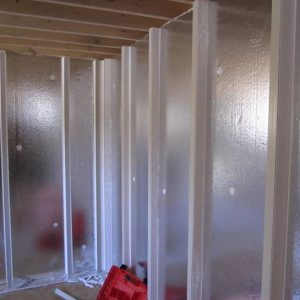It is common practice for insulated basement walls to have an air space between the insulated framed wall and the colder concrete wall. As well, there are new basement insulation systems that incorporate an air space between the rigid insulation panels and colder concrete basement walls. This is a bad idea. It creates an environment for condensation – which in-turn leads to mildew, mold and higher than expected energy bills and an uncomfortable damp basement. The Canadian Mortgage and Housing Corporation (CMHC) is very clear about the importance of eliminating air spaces between insulation and the interior of concrete basement walls.

Here’s what happens. Because the top of concrete basement walls are exposed to outdoor cold and the bottom of walls are somewhat insulated by the ground, the top of concrete basement walls are colder than the bottom. As a result, the air at the top of the wall between the insulation panels and the concrete is cold. Because cold air is heavier than warm air, it sinks downward towards the floor. This downward flow of cold air forces the warmer air upward. As the warm air is pushed upward it comes in contact with the cold concrete surface and condensation occurs i.e.: water, frost or ice.
This circular movement of air is referred to as convective looping. Convective looping also carries heat from the warm side (front) of the insulation to the cold wall behind it. This warm to cold movement of air significantly reduces the effective R-value performance of the insulation.
 Convective looping is virtually eliminated when rigid insulation panels are tight against the interior of concrete basement walls. Without air currents there is no mechanism for the air to transport moisture.
Convective looping is virtually eliminated when rigid insulation panels are tight against the interior of concrete basement walls. Without air currents there is no mechanism for the air to transport moisture.
Picture at right shows Quik-Therm CIS installed tight against interior concrete basement walls.
An excellent analogy to tight fitting rigid insulation panels against an interior concrete basement wall is a magnetic rubber seal on a freezer lid – tight against the storage compartment walls.
If the magnetic seal was eliminated, the freezers compressor would work overtime, it would consume more electricity and condensation, frost and/or ice would be happening where the lid met the storage compartment. Think of the gap between insulation and a concrete wall as a freezer lid without a magnetic rubber seal.
